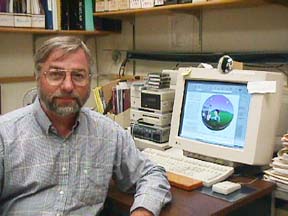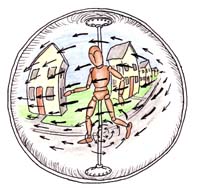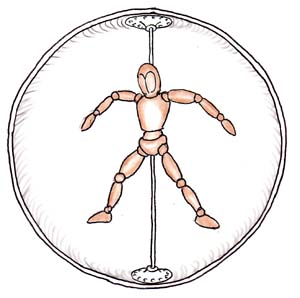An introduction to Steven Lehar, part I: Bubble worlds and force fields
Posted on 1 October 2022 by
Let me introduce Steven Lehar – a vision researcher with a PhD in Cognitive & Neural Systems from Boston University.
His body of work covers many fields: philosophy, neuroscience, aerobatic biplane piloting. You may have heard about him via Andrés Gómez Emilsson of the Qualia Research Institute; who recently welcomed him as a research lineage. Around these parts, he is most well-known for his contributions to a field you might call armchair phenomenology.

I first encountered the word phenomenology via my father, who was a quantity surveyor. There exists something of a cultural divide between builders and architects, and on this occasion, he was reading an architecture magazine, making fun of the pretentious language. “Phenomenology?! What does that mean?”
Whatever “phenomenology” was, it clearly had no place in the residential construction industry. But I must side with the architects on this one, because phenomenology has a clear definition – it means the study of subjective experiences.
Lehar is what we call a rational psychonaut, his model of phenomenology informed by use of psychedelic drugs – though it applies equally as well to states of sobriety. He is also a charming writer: he details his models and theories across several books and a heavily illustrated HTML website, and his prose is as entertaining as it is scientific.
I should note that I consider myself a qualia formalist, as defined in Mike Johnson’s Principia Qualia:
Qualia Formalism: for any given conscious experience, there exists – in principle – a mathematical object isomorphic to its phenomenology.
In this respect, I am a fan of Lehar’s model of phenomenology – that of bubble worlds and force fields – and although it remains relatively informal, I lean on it heavily to interpret my own subjective experiences. In that respect, I don’t think it matters if something exists as a LaTeX document or an illustration in coloured pencils.

I am also of the opinion that the conclusions he draws from this working model could have a wide impact on consciousness research. Certainly there are a few testable hypotheses in there, waiting to be explored – which will likely require a stricter standard of formality. I hope somebody out there can help finish what he started.
His collected works constitute a deep rabbit hole, so I think it makes sense to compile a guided tour. In this three-part series, I will highlight passages from three of his works – A Cartoon Epistemology, The Grand Illusion, and The Constructive Aspect of Visual Perception – and offer my own interpretation of his phenomenological world.
A Cartoon Epistemology
A Cartoon Epistemology is perhaps the best introduction to the world of Steven Lehar. It is an illustrated dialogue in three parts between an indirect realist and a naïve realist foil.
Indirect realism is the worldview that we never experience reality directly – everything we experience in our phenomenal worlds is in fact a simulated reconstruction of the external, noumenal world; the desert of the real we can never actually touch.
He introduces a bubble world model as a way of visualising the disjoint bubble realities we occupy inside our respective heads. He supports this model with careful observation of phenomenal perspective – a transformation required to compress an infinite space into a finite one. For a thorough exploration of the relevant mathematics, you can see his blog post on conformal geometry.

So what? So we are living in a scale model, and the scale of the model shrinks progressively with depth, just like a museum diorama, or a theatre set. And at the back plane the scale shrinks to zero, at least in the depth dimension, where everything beyond a certain distance appears flat, as if painted on the dome of the sky.
But it only looks that way. It’s an illusion. We know that the world isn’t really warped like that.

Yes but how do we “know”? We “know” by using a warped reference scale to judge the objective size of things in the warped subjective world. If we measure distances, and even straightness itself, using this warped reference grid, we can see that all the houses are the same height and width and depth, and that they are really all straight and vertical, not warped and bulgy as they appear.
I don’t know if I see anything warped at all! Looks perfectly straight to me!
When I first read about this perspective compression phenomenon, I couldn’t stop playing with it. Every morning, I would ride my bicycle around the neighbourhood, noting just how flat the houses and hilltops looked against the skybox behind them, some noninfinite distance away.
Some people find this phenomenon a little challenging to observe. I’ve introduced a few friends to this idea; some get it straight away while others have difficulty perceiving it. I have a pet theory that variation in attentional modulation and levels of dissociation make a big difference with regards to how noticeable it is; more on that below.
But, this only covers the shell of the bubble world! What happens inside?

Now despite appearances to the contrary, the little man at the center of our world of experience is not the viewer or ‘experiencer’ of the surrounding virtual world. The body-image homunculus is just the interface between perceptual and motor function, expressed as an explicit model of the body in an explicit model of surrounding space.

Motor computation takes the form of spatial field-like forces in that space, that bend the body-image homunculus into different postures.
Force fields are real, auras are real, you only have to believe. Andrés summarised it better than I could in Welcoming Steven Lehar as a QRI Lineage:
Another interesting nugget of insight is that in Lehar’s world, forces inside the world-simulation bias your motor actions and this is what renders and implements desire and disgust. In other words, there is something unexpectedly literal about saying that you are “attracted” to someone or something, or that an object or person “repulses” you! The way these forces are implemented can be conceptualized as fields that encode “how you would move at each point.” This proprioception is what guides the movement of our inner amodal avatar and how we plan sequences of actions.
Lehar makes us realize that as we navigate our environment, we move along something like a liquid membrane amenable to what feels like volitional influence, which guides our movement. This “force field” lives at the interface between our motor sensations and the volumetric representation of the external environment, and it works as a map between these two modes of experience.
These repulsors are what the rationalists call ugh fields; I sometimes call them cringe fields. Once you spot them, it’s hard to stop noticing them everywhere; I feel it when I’m driving on the motorway and suddenly become aware of another motorist in my blind spot. My body cringes away in the opposite direction, as if moving myself around in the driver’s seat will give the other car space.
Together, these force fields and the bubble world shell – or worldsheet, as it is known – compose a unified, volumetric world simulation:

So visual data is expressed in the visual representation, body posture is represented in the proprioceptive representation, and motor planning is computed in a global motor planning space. But all are coupled to form a single visual/proprioceptive/motor space, which is the space that we experience.
I have come to regard sustaining awareness of this model as a meditative exercise: I still take my bike out every morning, feeling the textured grip on the handlebars and the forces that guide my body, as the clouds and seagulls slide across my worldsheet.
I later found similar ideas in the expanded awareness of Alexander Technique and in Douglas Harding’s On Having No Head, but none was so concretely expressed as Lehar’s. Perhaps Lehar’s straightforward modelling had appealed to my literal-minded sensibilities where more poetic literature had not.
In the next post in this series, An introduction to Steven Lehar, part II: Symmetries and periodicities, we’ll take a look at his autobiography, The Grand Illusion – in which Lehar answers the question: what happens when a vision researcher takes acid?
Open questions
I like ontologies. I love to cram things into ontologies in order to understand them. When my ontologies are incomplete, I feel incomplete, but I also have much love in my heart for the incomplete things that inhabit heaven and earth.
As an exercise in qualia formalism, I am going to sketch out an ontology for a momentary qualia state based on Steven Lehar’s bubble world model above, and then I am going to ask it some questions to gauge its completeness – or lack thereof. This is the working model I use to reason about my own subjective experiences.
For the purposes of this discussion, I am going to use the terms worldsim and worldsheet to refer to the bubble world and bubble world shell, respectively. These terms have established precedence; but I would also like to use the term worldfield to refer to the force field, for the sake of etymological completionism.
From the top down, we have:
- The worldsim, which contains:
- the worldsheet, a two-dimensional surface where each point has both:
- depth, a scalar value, and:
- colour, a three-vector value; and:
- the worldfield, a three-dimensional vector field.
- the worldsheet, a two-dimensional surface where each point has both:
What belongs in the worldsim, and what does not?
This is a big question. How do we draw the line between the conscious and the subconscious? If you were able to take a snapshot of your global qualia state at a given moment – what would you find in that picture?
The subconscious appears to be the realm of priors, which are not directly represented in our sensory experience. By way of an example, the motor planning fields descibed above – encoding predictions about the way we should move – are not actually felt directly in the same way we feel touch, only indirectly by their influence on our musculature.
What is the worldsheet’s topology?
One could make an argument for the worldsheet being open; what goes on behind your head? There is an important distinction between black and absence of stimulus to be explored, here. Some people report experiencing 360 degree vision on psychedelics – which should really be called 4π steradian vision – which I think provides a solid counterargument.
If it is closed, could it turn from a sphere into a torus, or something even weirder? We already know that under the influence of DMT, its curvature can change from Euclidean to hyperbolic; so other strange transformations don’t seem so far fetched.
Does the worldsheet bound the worldfield?
Colour as the paint on the walls of the worldsim – it has a conceptual elegance to it, but is immediately disproven by the following experiment: Raise one hand into your field of view, and use your other hand to tickle the side facing away. Something is stirring behind the Cartesian theater.
Or, perhaps they are both spherical in shape, interlocking perfectly – and the depth map itself is illusory?
What is depth?
A depth map is a solution to the inverse optics problem, that much we do know.
I must skip ahead; I haven’t yet covered The Constructive Aspect of Visual Perception, which should hopefully explain everything. Suffice it to say, there is an inverse relationship between an object’s size and the frequency of the oscillatory processes that reify it. Perhaps variation in depth is actually just variation in wave propagation rate?
What is colour?
The CIE 1931 color space was first mapped out in the 1920s – but this milestone in qualia cartography was only conducted on sober humans.
Psychedelic trip reports come in from time to time of people claiming to see unusual colours; but as far as I am aware these just tend to be imaginary colours – colours from outside the usual gamut – and not the higher-dimensional colours one might hope for. Are three dimensions of colour a limitation of the medium? A physicalist theory of consciousness should be able to shed some light on the matter; but I am yet to see such a theory in the wild.
Fish and birds are tetrachromats – and let us not speak of the notorious mantis shrimp. Wouldn’t it be a shame if all that high-dimensional input was rendered into a three-dimensional latent space?
I have four senses other than vision; are there multiple worldfields, too?
The answer is, I couldn’t possibly tell you. However, a unitary worldfield has a reductionist appeal, so I’ll explore the idea here.
One thing that touch, sound, taste, and smell share in common is that they are all localised phenomena – they happen at a particular location in space. We don’t hear a sound in our ears; our brains perform some incredibly impressive calculations to estimate its location before injecting it into our worldsim as localised worldfield pertubations.
So what gives these pertubations their distinctive phenomenal character? Without getting into too much depth, I’d say it’s the dynamics of the oscillatory processes that reify them. Sound has high bandwidth and low spatial precision; touch has low bandwidth but high spatial precision – and their afterimages work in different ways, too. When music stops playing, you might continue to hear a short loop in your head; but touch afterimages tend to manifest as a persistent model of your immediate surroundings.
Taste and touch can be a fun cross-modality to explore: Next time you eat some ice cream, see if you can disassociate the raw sensation from its semantic content. Try to observe how the sweetness sensation interacts with the coldness sensation. Is it all really just vibrations? Do they harmonise?
What makes all this more or less visible to some people?
As I noted above, some people have a hard time noticing phenomena such as the worldsheet via perspective compression. Dissociatives such as ketamine block the NMDA receptor network, suppressing sensory processing – which can make these phenomena easier to observe. Meditation can also have similar effects.
But some people have no choice but to experience these things, and this can be quite confronting. Transgender writer Zinnia Jones suffers from depersonalisation-derealisation disorder, and found that her symptoms were dissolved completely when she started hormone replacement therapy. Seems reasonable – one of the many things estrogen is known to do is upregulate NMDA receptor expression.
She ran an experiment where she stopped taking her hormones to see if replacing them with lamotrigine would also suppress her DP/DR symptoms. Most fascinating is her description of the visual aspect of DP/DR:
I can almost envision everything on our street coming apart piece by piece like an exploded technical diagram. The asphalt, the curb, the patches of grass, all of them could just lift into the air and drift apart, nothing but thin surfaces, almost like abstractions or mere representations. If I were to take a shovel and start digging a hole in the road, it would just be an indentation in that surface, pushing it to extend a bit in one direction or another – but underneath it, nothing. The houses along the street are just outgrowths of the surface, a sort of puckering in it, like a ball on a rubber sheet to demonstrate how gravity is the curvature of spacetime.
I tell Penny about this – she’s a computer animator, and says she experiences something similar when watching movies, seeing all the CGI effects as just flat and artificial creations overlaid on a background. The difference is that I’m seeing this when I look at the real world. It’s an incredibly uneasy thought, but I can’t shake it. I start to realize what’s been missing in my world for the past week. It feels like there could be an infinite chasm behind the surface of everything – the idea of objects having solidity and depth is unconvincing, and it just doesn’t register for me. There’s a sense of standing at some cliffside, with the entire world nothing but a thin and fragile shell between me and the endless void. Perceiving the world felt like walking on ice that could crack at any moment.
This isn’t something I want to continue to experience, and I go back on my hormones immediately. The strange sensations subside within a couple days.
I relate to this – it closely resembles what I see on my bike each morning, though far more extreme. It seems that while sensory insight can be a playful meditative exercise for some people, it can be a terrible burden for others.
What makes the difference? Perhaps it’s the degree to which one integrates indirect realism into their worldview – but it seems trite to suggest this to somebody who’s suffering, when proven neurochemical solutions are ready at hand. But Zinnia seems cool – so I had to ask her what she made of Steven Lehar.
She kindly got back to me in the middle of Hurricane Ian:
“Notably, I have always been particularly annoyed when I notice this necessity of space being compressed into a perceived perspective cone or what have you, instead of just being able to ‘see’ things at 1:1 at any distance. Even though everyone keeps telling me that’s impossible. This is the first time I’ve seen a suggestion that this is indeed just one of many possible perspectives and not a necessity inherently.”
